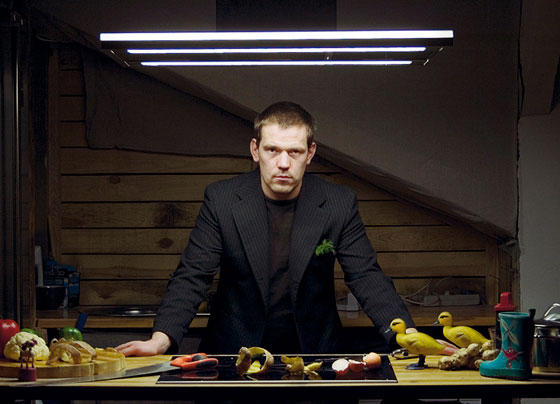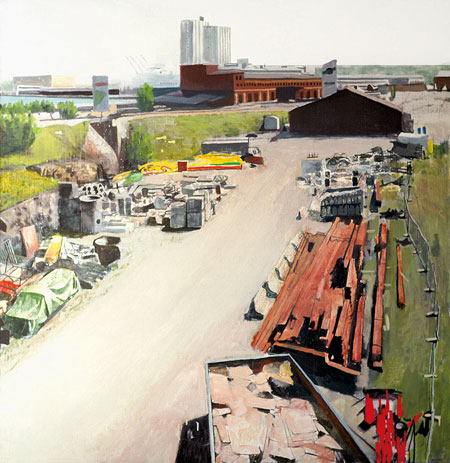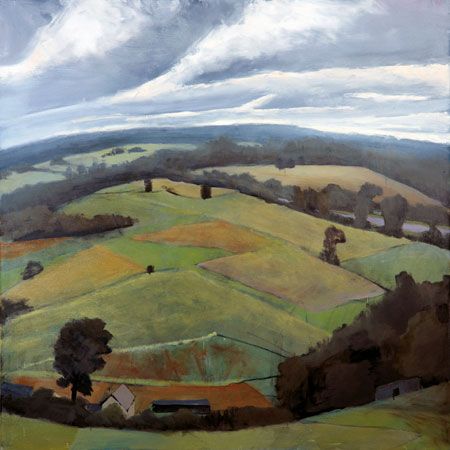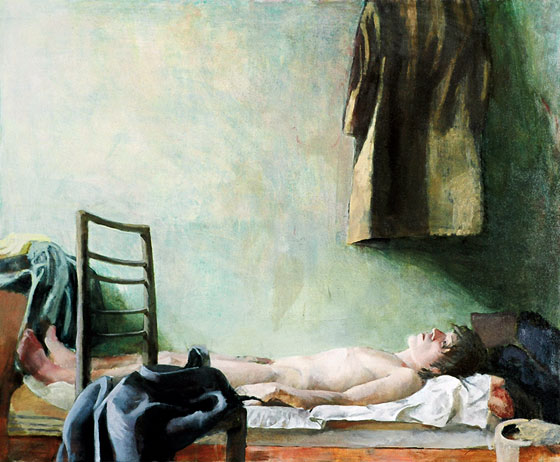|
|
| A way of becoming a better person Diāna Barčevska Painter Andris Eglītis | |
 Andris Eglītis | |
| Born 24 June, 1981
Education: 1992-1999 Janis Rozentāls Riga Secondary School of Art 1996-1999 Studies of photography at the ANNAS2 Centre for Creative Learning 1999-2003 The Painting Department of the Latvian Academy of Art, BFA 03/2002-06/2002 Studies at the Fine Art Department of Manchester Metropolitan University 09/2004-12/2004 Studies at Ilya Repin St Petersburg State Institute of Fine Arts 2003-2005 The Painting Department of the Latvian Academy of Art, MFA Lives and works in Riga, Latvia Young artist Andris Eglītis is a serious person, and the same can be said for his art. He has no juvenile bravado or pretentious self-satisfaction. He is pleasant, attentive and expresses each thought with great care. Eglītis has attracted attention and prompted appreciation ever since he first started taking part in exhibitions. In describing his paintings critics produce conceptual accounts of feelings and ideas - which means his works provoke emotion and stimulate the intellect. Eglītis' art is a transformation of reality, the definition of which is yet to be formed. The young artist has sometimes been termed a representative of Neo-Academism in contemporary Latvian art, whose work confirms the inherent presence of academic values in contemporary painting. Eglītis himself has expressed a desire to learn clarity of thought and serenity from the old masters, perfecting pictorial qualities. Diāna Barčevska: Tell me about the moment when you realised you wanted to paint! Andris Eglītis: Mostly in the classic manner - art school, the academy... I had some doubts and depression, and then I had the idea of not painting for a year after graduating from the school, just to see if it truly was what I needed. I still had my doubts when I started my studies at the Academy, but then, in my third year, I went to the University of Manchester on exchange. There we just sat in the library, talked, thought etc. Perhaps that was when I realised that this was the best thing I could do and also found the direction to move in. D.B.: Which was? A.E.: It is still relevant - the painting style I'm developing, because emotionally there's no difference between portraits, landscapes and still lifes. It is a single entirety I am striving for. It is important to me to make each of my works relevant to me as a person, and also to invest it with a message. In real life it isn't always possible to do painting all the time, but in my case it is just as well, because through doing other things I mature as a human being, and I have more to say as a painter. D.B.: Let's talk about the issue of maturity - about personality and how it is manifested in art. A.E.: In Manchester I reached that point where I realised I had to change as a person if I wanted to achieve something as a painter, I had to improve myself, because "life is an uphill journey" - I had to become a better person. Until then I had resembled a schoolboy who thinks he can do things "whichever way"... Anybody can learn to paint, but at some point you have to realise what matters to you. D.B.: How important were your studies at the Academy of Art? A.E.: An Estonian artist I know once said he didn't know any artists who would say good things about their school. I think of myself more as a product of the Rozentāls art school, not the Academy. With regard to drawing skills, I learnt a lot during my time at the State Institute of Fine Arts in St Petersburg. | |
 Andris Eglītis. Painting Nr. 18. 2003 | |
|
D.B.: How important is the role of a teacher in an artist's life? A.E.: If you happen to get a good professor, it is the greatest luck you can imagine. To me, the time spent studying with Elita Svikle at the Rozentāls School was very important. D.B.: Who are your authorities in art? A.E.: They change. At one time I was inspired by photographer Beat Streuli - looking at his photographs I was overcome with happiness and the desire to paint. At the moment I like David Hockney, also Edward Hopper... In portrait painting I am inspired by Elizabeth Peyton. D.B.: How do you pick the subject of your paintings? A.E.: I don't know. You could say perhaps that the subjects pick me, or something just as trite. There are moments when you're living your grey, mundane and uninspiring little life, or even your colourful, extraordinary and inspiring one, and everything just clicks into place and you get the feeling you've GOT IT!!!, which is accompanied by shivers of delight, restlessness and the conviction that everything is wonderful and possible. In a word, an imaginary painting has been born. And then comes the usual process of accumulation, capsulation, crystallisation and implementation. D.B.: Is the presence of principles of academic painting important in your art? A.E.: I don't precisely know what academic painting is - or I know it under a thousand different guises, most of which I find quite repulsive. The term itself, "academic painting", is not very attractive either, at least as a description levelled at me. It could perhaps be called objective painting instead. I avoid the term "realism", because it is even more pretentious and vague than "academism". What is important to me is that my paintings may be identified with reality, to a greater or lesser degree of relativity. So, to achieve this goal I use a wide array of painting resources, which can perhaps be termed academic. It has to be said that good art and good painting are not one and the same (even if we're speaking of paintings exclusively), and what I aim for isn't just pictorial (formal?) values, it is much more important to strive for that elusive and mystical art. For me, however, a large part of painting as a genre is missing what I would call pictorial intelligence. As I was copying a work by Ribera at the Hermitage in St Petersburg, I felt I would love to achieve that sort of serenity, and paint in that much detail, as thoroughly and deeply as artists were doing back then - just with a contemporary feel. But then I realised I wasn't quite suited to that, and the idea of single-session portraits logically followed from that... D.B.: Tell me about your period of portrait painting - why did you take it up? How did it start? A.E.: This is how it went. I had completed my work on a series of studies of Beat Streuli, on which I had spent almost six months. It was certainly a great process, but it reaffirmed my belief that painting is best done "live": if you need a scene of mundane urban life, you must close off a street, stop all the people and buses, and paint away. As I was entertaining these thoughts, I was invited to take part in a rather quaint but informal painting session in Berlin. And there, as a result of some chain of causes and effects, it so happened that I had to paint a portrait of a hotel employee over the course of one evening, in a single session. So that was how it was done, and right then everything clicked into place again and all the green lights went on. I can't explain it in any more detail, but at that moment I realised I had to paint a series of these portraits, which would help me to narrate the Truth. | |
 Andris Eglītis. Painting Nr. 12. 2003 | |
|
D.B.: Photorealism - to what extent do you relate it to your art? Have you had any conscious thoughts on this mode of expression? A.E.: I have never identified with Photorealism, even though I've used photographs; there was a moment when I realised it was hindering me. The best things come from nature. If you paint without a photograph, the work will have more of you in it. A photograph is reproduction in a way. I don't pretend to be able to explain what I have painted, because when you're painting, your verbal thought is just one of the parts of the process - there is also the wisdom of the hand. All of it comes together to create that miracle. D.B.: What, in your view, is contemporary about your painting? How is this age reflected in your art? A.E.: I don't set out to be intentionally original and contemporary, I don't wish to create something new and heretofore unseen. I just want to be a painter who knows how to paint any idea that comes to him. Smug originality bothers me. As for the contemporaneity - if your works capture a sense of period, they are going to be contemporary. D.B.: How do you see our time - life, art -, what are its characteristics? What is your affiliation with this age? A.E.: I feel it as a simultaneous existence of many different worlds. In the sense that globalisation and the availability of information sorts people into interest groups that can exist on their own, independently of others. Everyone just boils away in their own kettle. A while back, being a painter meant you could be relevant across the entire field of art; these days it may never happen, but you have to do what you want, and time will put everything into its place. D.B.: Can good marketing make an artist? A.E.: Definitely, up to a certain level. Depends on the position one takes. There are several examples of good marketing making a great deal of difference. I think of myself as an introvert and never organise anything for myself. I just concentrate on work, and, if you are doing your work, everything else will come. D.B.: What would be the ideal situation for self-fulfilment as a painter? A.E.: My main aim in life is to become a better person, and painting is like a tool - a way of achieving that. By this I mean becoming more genuine, with a clearer mind and consciousness, and more developed morals in the never-ending battle with my own weakness, stupidity and insincerity. But, if I don't get to do any painting for a longer while, I become cranky and unbearable. Many Academy graduates have organised their life in a way that lets them devote all their time to painting, with no real need to earn their bread, but quite often it doesn't lead to anything worthwhile... Personally, I have found that longer spells in the studio make me become helpless in my everyday life. | |
 Andris Eglītis. Painting. 2002 | |
|
D.B.: Life is lacking in excitement and challenge? A.E.: Yes, but at the moment all my circumstances fit together very well. D.B.: What do you have besides painting? A.E.: My work, my family. A wife and two children. Over the last two years I've invested my energies in repair and redecoration. I do my best painting when I go away somewhere. This year I was in Stokholm, on the invitation of the Swedish IASPIS organisation. I lived and painted there for two months. The aim of this event is communication and an exchange of ideas. D.B.: What is your opinion of the processes in Latvian art? A.E.: What is taking place here is commercial gallery life. There is no higher-level movement in art. Contemporary art here hasn't put down roots as an organic component of culture life; instead, it is about little jokes, unsubstantiated provocation or the activities of self-sufficient oddballs. D.B.: What would you like to achieve as a painter? With what sort of resonance? A.E.: I would like to have an independent place for exhibiting my work, a place where it could be seen by people who are important to me, whose opinions matter to me. There aren't many such people, but that is only logical, because this is a tiny country. I try not to think in categories like "a Latvian artist in Latvia". It's not that difficult to go somewhere, London for example, and see something worthwhile. I don't attend local exhibitions much, either, because usually they're very disappointing. We just don't have the painters... But that's a normal occurrence - during my two months in Stockholm I went about looking, but there was very little satisfaction. Maybe there's a time lag before it kicks in. I'm not the type to go wild about things. I look all over the world for art I want to live with, and when I find it it's always very clear to me that art is wonderful. D.B.: Does critique have any significance in the life of an artist? A.E.: Personally, I am influenced by any opinion. In the sense that you may hear something about yourself you hadn't thought of before. If a critic says you should drop painting, but you don't have that conviction yourself, then it will never happen. You have to be selective about what to take on and what to ignore, but I always remind myself that critics very rarely say what they truly mean. I know this because I used to write critiques on Latvian art exhibitions myself. Here it is largely based on personal relationships. See, how are you going to write anything nasty about a lovely person... D.B.: What do you wish to convey through your art? A.E.: First of all, as is usual upon answering this kind of question, I want to say that if I were able to verbalise the things I want to say with my art, I would just say it and not have to bother with the paints - also, I should reiterate the point that good art and convincing interpretations of art are quite often mutually exclusive. Although I don't think an artist should necessarily be unable to string two words together. I think I mean my art to be a reminder of certain things, or to create an effect instead of saying something. Here's one way of trying to explain the feeling, impression or effect that I'd like to achieve with my works: from time to time, there comes a moment when you happen to find yourself on a higher plane of being, in which a particularly acute awareness, senses and feelings all come together. These are the moments when you get the pretentious notion that you've perceived the very essence of things. This is accompanied by a feeling of happiness and fulfilment. The triggers of this condition are certainly not limited to the visually perceptible environment, but in this state you may see a situation or discover some connection between things, which you may paint and invest with a coded message about it. So in my work I try to charge these seemingly random fragments of everyday life with energy, feelings and associations, which would ideally provide the viewer with information about this higher plane of being and serve as a catalyst for achieving it. In other words - you could say I paint small fragments that reflect the essence of things. They carry thoughts, associations, morals and ethics, and also have a direct visual impact. I think I could come up with a pretty good description of my efforts by involving the concept of God, but I shall refrain from it this time. I have to say my efforts are very fragile, indefinable and impossible to prove, and in no way didactic. You could just as surely say that I paint banal landscapes, mundane little scenes and vaguely psychological portraits. | |
| go back | |







